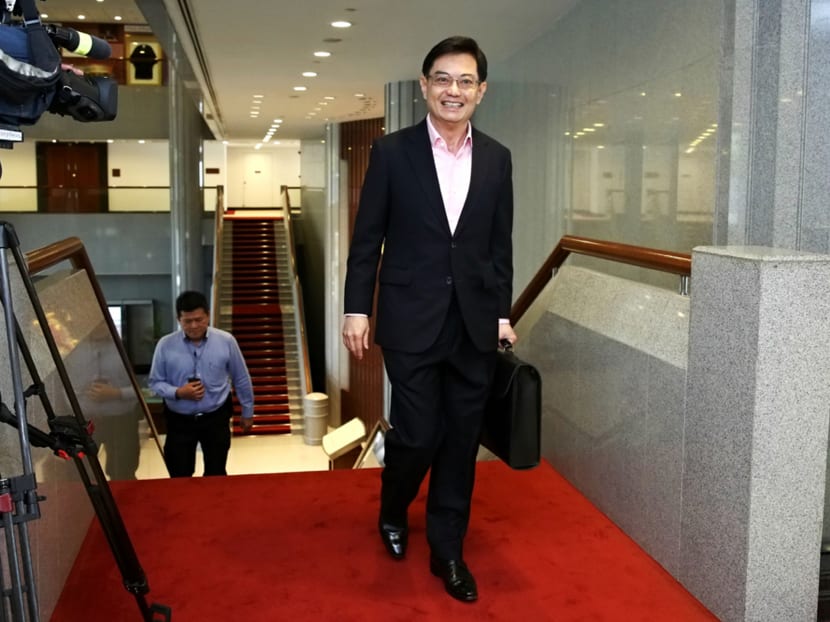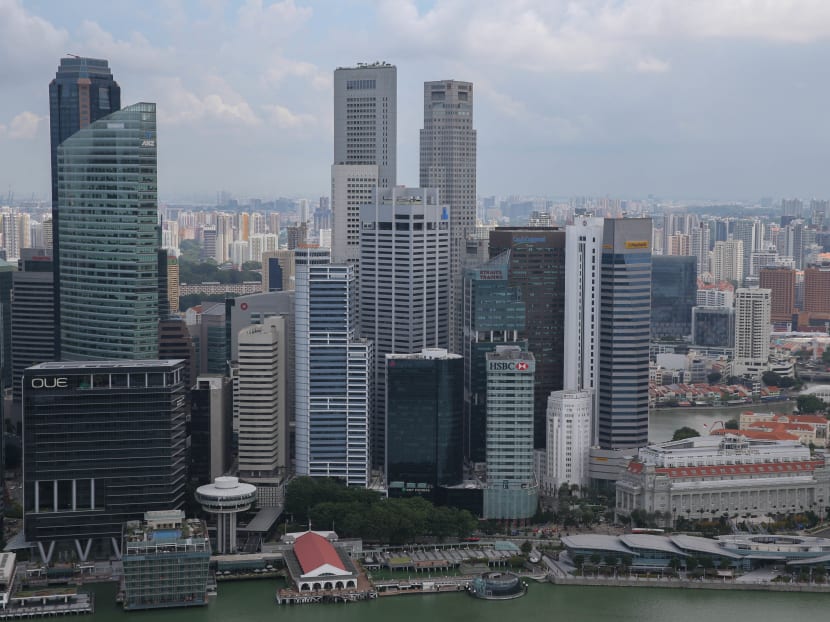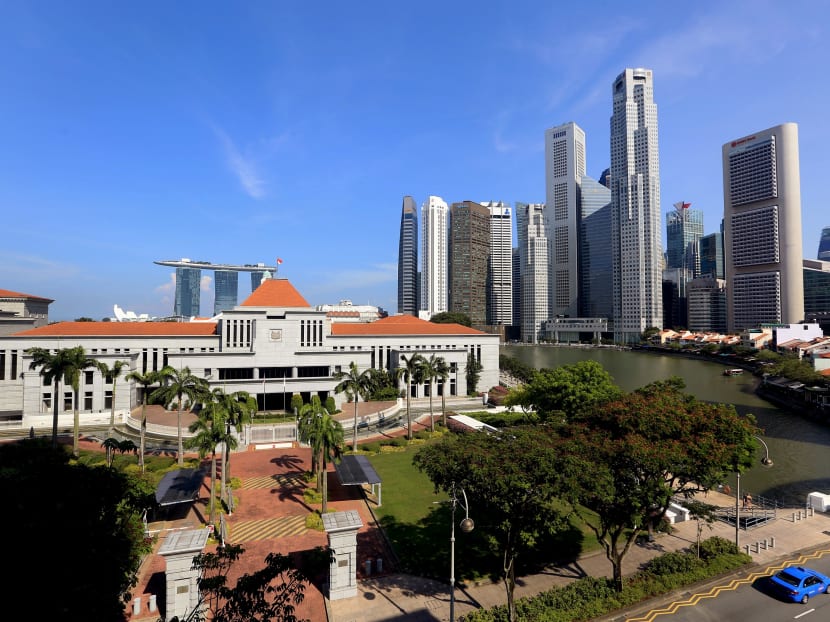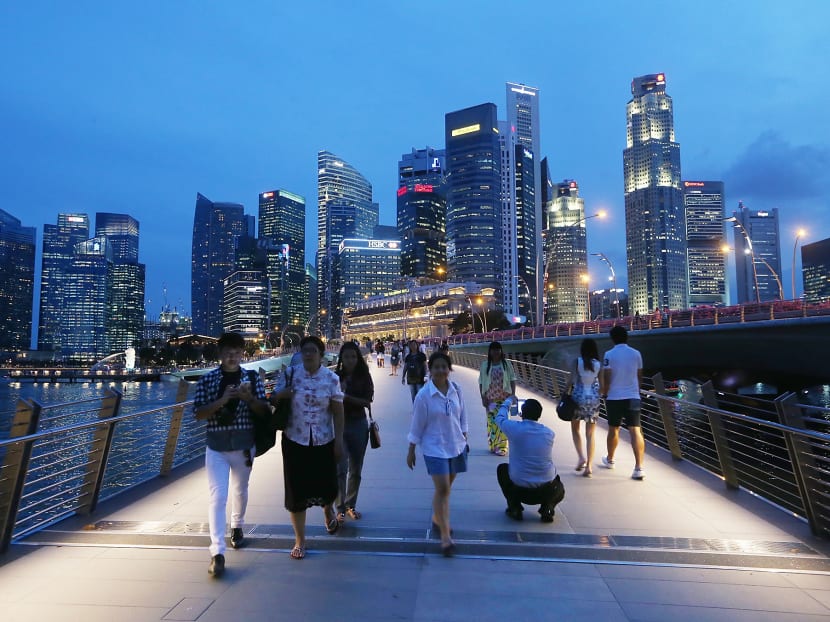The Big Read: An unconventional Budget, in more ways than one
SINGAPORE — To the keen observers, what stood out from Budget 2018 earlier this week was not the record surplus which was attributed to exceptional factors.
SINGAPORE — To the keen observers, what stood out from Budget 2018, delivered earlier this week, was not the record surplus which was attributed to exceptional factors.
Neither was it the proposed wide-ranging Goods and Services Tax (GST) on businesses providing digital services, which will cover a broad swath of e-services ranging from downloadable digital content such as mobile applications, e-books and movies, to subscription based media including news, magazines, streaming of TV shows, music and online gaming.
It was also not the impending GST hike which will kick in some time between 2021 and 2025 – or at least not the 2-percentage point increase per se.
Rather, it was the timing, with the announcement coming at least three years before the tax increase kicks in – a practice almost unheard of in democratic societies, as Minister in Prime Minister’s Office Chan Chun Sing pointed out on Saturday (Feb 24) during his speech at a Chinese New Year dinner for the Tanjong Pagar and Radin Mas constituencies.
But Mr Chan stressed the need for government to be honest with its people, while Finance Minister Heng Swee Keat also said earlier that the ruling People’s Action Party must have the courage to do “the right thing” and “not make narrow personal calculations”, despite the political costs of announcing the tax increase before the next General Election (GE) due by January 2021.
Still, political analyst Associate Professor Eugene Tan said there is a risk that the deferred implementation could be a “constant thorn” for the People’s Action Party (PAP). “It keeps the issue very much alive and will probably invite ongoing gripes, unhappiness and contestation for the next couple of years,” said the Singapore Management University law lecturer.
Apart from the timing of the GST hike which caught observers and experts by surprise, the fact that the statutory boards and government-owned firms will be encouraged to borrow money to build critical national infrastructure – with the Government looking into providing guarantees for the long-term loans – also caught the eye. In his Budget speech on Monday (Feb 19), Mr Heng said this approach will spread out the costs of major investments over more years without directly drawing on reserves. It will also help boost the bond market, he added.
Observers and expert pointed out that this is a fundamental shift by the Government in terms of its fiscal approach, by having current and future generations sharing the burden of financing critical infrastructure projects. But this is a move towards fostering greater prudence “as long as fiscal discipline and careful planning is adhered to”, said Mr Desmond Teo, financial services tax partner at accounting firm Ernst & Young Solutions.
Mr Teo added: “There will be a financial burden on current and future generations to service the debts, but this should be fine as long as the debts are used to acquire key assets that generate returns exceeding the financing and capital costs associated with them.”
‘KILLING TWO BIRDS WITH A STONE’
Unlike countries that have to sell securities to keep the lights on, Singapore has never needed to finance recurrent expenditures by borrowing – and it will stay this way.
Mr Heng had stressed that borrowing for recurrent spending – such as healthcare, security and other social spending – is off the table because it will put the burden on future generations.
With his strong emphasis on prudence, founding Prime Minister Lee Kuan Yew had set the tone for the Government to always live within its means. “We do not need to borrow vast sums of money, because we have not overspent. When we do have to spend more than we earn that year, we have savings to dig into,” the late Mr Lee had said in the early 1980s, according to a published collection of his quotes titled The Wit and Wisdom of Lee Kuan Yew.
Nevertheless, the Republic is now looking to tap into the capital markets for long-term investments that will reap returns.
The experts lauded the move as a “sensible plan” that kills two birds with one stone: Firstly, by lessening the burden on the Republic’s finances at a time when spending is expected to outstrip revenue. Secondly, it will inject vibrancy into Singapore’s capital markets.
Over the years, there has been consistent demand from life insurance companies and asset management companies for high quality Singapore dollar-denominated local bonds, said UOB head of markets strategy Heng Koon How. While some public agencies, such as the Housing and Development Board (HDB) and Land Transport Authority, are already using bonds to finance infrastructure projects, new issuing agencies and companies will “provide (investors) a welcomed diverse pool of credits to choose from”, he added.
Singapore is currently the only Asian country with long-term AAA credit ratings across all three major rating agencies (Moody’s, S&P Global, and Fitch). Globally, fewer than 10 countries have attained this coveted measure of financial strength.
“So the market is definitely excited about this and looking forward to the new issues,” he said.
CIMB private banking economist Song Seng Wun added: “After 50 years, the Singapore Government has built its track record. Investors know it will not go belly up… It will be able to borrow because of its history and credit rating, and this approach will give us easier access to funding, freeing up the Budget for other more pressing needs.”
The National Environment Agency’s upcoming Integrated Waste Management Facility, the Kuala Lumpur-Singapore High Speed Rail, the Johor Bahru-Singapore Rapid Transit System Link and Changi Airport’s new Terminal 5 were cited in the Budget statement as examples of projects that may be funded by infrastructure bonds.
While the Government had said the approach is confined to financing critical national infrastructure, UOB’s Mr Heng Koon How felt that it could include the redevelopment of different parts of Singapore, such as the Jurong Lake District, Punggol Digital District and Woodlands North Coast, as well as the rejuvenation of other public infrastructure in mature HDB estates.
Former PAP Member of Parliament Inderjit Singh reiterated that the Government is still demonstrating prudence by using infrastructure projects as collateral. “Government surpluses can be put into reserves to earn higher interest (to cover) the cost of borrowing. It therefore makes a lot of sense,” said Mr Singh, a veteran entrepreneur who has founded several firms.
DEEPENING PRIMARY AND BASIC DEFICITS
While the Republic is expecting a record S$9.6 billion overall budget surplus for this financial year ending March 31 owing mainly to “exceptional” contributions by the Monetary Authority of Singapore (MAS) and higher-than-expected collections from stamp duties, the Government and economists have stressed that these are “one-off” factors.
Finance Minister Heng Swee Keat had cautioned while delivering the Budget statement: “It is not a structural surplus. We cannot base our long-term fiscal planning on the basis of exceptional factors being positive, year after year.”
The Republic’s fiscal position had gone through troughs and peaks over the last two decades, but it has recorded more overall budget surpluses — in 15 out of 21 years since 1997 — than deficits. However, its primary and basic balances, which take into account special transfers excluding top-ups to endowment and trust funds, have deepened into deficits in recent years.
Government Budget and Fiscal Position, Annual. Source: Data.gov.sg
Several economists had told TODAY that a deficit position is not necessarily a cause for concern as long as the Republic’s gross domestic product (GDP) continues to grow. Surpluses from previous years are “expected to be ‘recycled’ and put to good use to enhance Singapore’s economy and the quality of life”, said CIMB’s Mr Song.
Moreover, a bulk of the Republic’s expenditure would go into infrastructure projects, which also go towards boosting GDP, the experts added.
As Singapore’s spending needs will continue to grow across all sectors — particularly in healthcare, security, infrastructure and education — the Republic must look at various options to strengthen its fiscal footing, so as to manage planned expenditure needs and prepare for unforeseen ones, Mr Heng said on Monday.
“In the next decade, between 2021 to 2030, if we do not take measures early, we will not have enough revenues to meet our growing needs,” he said.
ON THE RESERVES
While Finance Minister Heng Swee Keat and Senior Minister of State for Law and Finance Indranee Rajah had repeatedly stressed that the Republic must be judicious in its use of expected net investment returns, some observers feel there is still potential to tap deeper on the country’s reserves.
The Net Investment Returns (NIR) framework introduced in financial year 2009 allows the Government to spend up to half of expected real returns from assets managed by the MAS, Temasek Holdings, and the GIC.
In FY2016, the NIR contribution (NIRC) overtook corporate income tax collections for the first time to become the Republic’s largest source of revenues.
In delivering the Budget on Monday, Mr Heng Swee Keat argued against spending 100 per cent of the NIR, warning that if this is done, “the principal sum of reserves will stagnate over time, and the NIRC as a share of GDP will consequently fall as our economy grows.”

This year’s Budget seeks to position the Republic for the future through what Finance Minister Heng Swee Keat called a “strategic and integrated plan”. Photo: Nuria Ling/TODAY
Two days later, Ms Indranee stressed that using half now and saving the rest for the future is “not a science, but a discipline”.
Economist Donald Low has suggested that raising the NIRC limit to 60 per cent would add an estimated S$3 billion to national coffers each year — almost exactly what a 2-percentage point increase in GST would yield, in perpetuity.
Mr Low, who is associate dean for research and executive education at the Lee Kuan Yew School of Public Policy, said: “Just because 100 per cent is not prudent doesn’t make 50 per cent right either. There’s nothing scientific about spending just 50 per cent of the investment returns.”
While some economists felt raising the spending limit could set future governments on a slippery slope by “killing the golden goose”, Mr Low said the Republic could accept a slower rate of reserves accumulation as “future generations are likely to be richer than the current generation entering retirement”.
On Saturday, Minister in Prime Minister’s Office Chan Chin Sing warned that there are severe implications if the Singapore dollar is not strong and the country does not have sufficient reserves as buffer.
Mr Chan acknowledged that it is a “fair question” to ask if the Government should spend more of its earnings from the country’s reserves. But he pointed out that “every dollar we save and put back into the reserves will help us earn more than that dollar to meet the needs of our future generations”. He added: “This is especially important when our population is not growing as fast and when our population ages.”
One other way to tap the Republic’s past reserves is through revenue from land sales, said Mr Singh.
Currently, land sales revenue is excluded from budgetary spending. Under the Constitution, state land and revenues from land sales form part of Singapore’s past reserves, which are invested.
In FY2017, proceeds from government land sales came up to S$12.9 billion (2.9 per cent of GDP), higher than the forecasted S$8.2 billion.
“The government owns land and assets that are worth much more than what GIC and Temasek own… The net income from the sales of land is quite substantial and if the Government also adds this to the NIRC, I believe there should be sufficient income for (it) to spend in the foreseeable future,” said Mr Singh.
However, the Government had repeatedly stressed the need to prevent a situation where the government of the day sells land just so that it can meet its expenditure needs. The constitutional prohibition also ensures that the government plans its long-term Budget prudently.
GOVT ‘CAN DO BETTER’ IN MANAGING COSTS
Apart from mulling over ways to raise revenue, the Government could do more to manage costs, the observers and experts said.
While recent Budgets have attempted to foster fiscal discipline within public agencies, they pointed to the public sector lapses and wastage regularly uncovered by the Auditor-General, among other things.
Citing the example of healthcare, DBS economist Irvin Seah noted how healthcare cost inflation which averaged 2.6 per cent in 2017, was significantly higher than the overall inflation rate of 0.6 per cent.
“There is a need to review the current cost structure and streamline the administrative processes of Singapore’s healthcare system. Ultimately, subsidies will never keep pace with (cost) increases if costs are not kept in check, particularly given the ageing demographic profile. And this applies to all forms of social assistance schemes,” said Mr Seah.
He added that beneficiaries of such schemes should be held accountable through mechanisms, such as co-payments, to stem potential abuse and ensure sustainability.
While it is “laudable” that Mr Heng Swee Keat had renewed his commitment to cost efficiency in Government by further moderating ministries’ budget growth, the moves have been “relatively gentle”, said Mr Devadas Krishnadas, a former civil servant who is the chief executive of international strategic consultancy Future-Moves Group.

TODAY file photo
The growth rate of ministries’ block budgets, which stand at 0.4 times of GDP growth, will be reduced to 0.3 times from FY2019. Last year, the Government had also announced a permanent 2 per cent downward adjustment to the budget caps of ministries and organs of state.
“It is reassuring that Mr Heng continues to focus on cost of government. However… it would have been ideal if the minister had indicated a target for the Budget-to-GDP range as a form of fiscal discipline for future fiscal planners…Setting a guideline range as a measure of restraint would indicate cognisance of the danger of budget creep in the face of expenditure pressures becoming normalised and self-justifying,” Mr Krishnadas wrote in a commentary published by TODAY.
Agreeing, Mr Singh said the Government should place a greater focus on cost reduction and sharing its efforts with the public.
“I feel there is a lot more potential in managing costs, but the Government has not demonstrated their ability to do this well yet. If it does not address the costs and continues to burden Singaporeans with more taxes, it will create a problem of trust for the Government,” he said.
For instance, Mr Singh noted how public procurement projects can sometimes be managed by smaller suppliers with lower quotations.
“There may be alternative suppliers who can do a better job at lower costs. But because government officers don’t want to take the risk to deal with smaller suppliers (which may actually have better technology than the big players), so they pay higher,” he said.
POLITICAL COST OF GST ANNOUNCEMENT
Away from the fiscal issues, the observers and experts noted that the impending GST hike will likely become a hot-button issue which the Opposition will seize on during the next GE.
As a result, the PAP will need to tap on a large stock of political capital. Nevertheless, the tables could be turned on the Opposition, when they are asked to come up with a better plan to fund the rising expenditures.
“The opposition parties would need to propose more viable options that, perhaps, have been tested with much success elsewhere in other developed countries,” said Dr Felix Tan, an associate lecturer at SIM Global Education.
First introduced in April 1994, the GST was raised from 3 to 4 per cent in 2003, and then to 5 per cent in 2004. The last change was in 2007, when it was raised to 7 per cent.
Over the years, GST rate hikes were typically announced about six months before they kicked in.
Institute of Policy Studies deputy director for research Gillian Koh noted that this is the first time a GST hike has been announced during one parliamentary term, to be implemented in the next.
“With a GE in between, a lot will depend on what the government leaders do now with this ‘advance notice’ to determine how the issue will play out in the next elections,” said Dr Koh.
Among other things, it would depend on how the authorities explain the use and necessity of this hike to the people, she added.

Aerial view of the Singapore Parliament House and Central Business District (CBD). TODAY file photo
Prime Minister Lee Hsien Loong had said that he plans to step down some time after the next GE, and the observers believe that Mr Lee could tap on his vast political capital to front the GST hike during the elections.
Mr Singh said: “It has always been the practice of our leaders to take on the unpopular policies and not burden the next generation leaders.”
Agreeing, SMU’s Assoc Prof Tan said that Mr Lee should not be seen as “kicking the can down the road”. “It is only proper for Mr Lee to carry through the hike before he hands the premiership to his successor. It is a policy his government decided on and he should see it through even if it is one of his final decisions as Prime Minister,” he noted.
Nanyang Technological University political scientist Woo Jun Jie said that Mr Lee’s popularity and political capital “will certainly help to mitigate any public discontent with the hike and help the (PAP) rally public support”.
One way for the ruling party to possibly reduce the political cost of the impending GST hike would be to hold early polls, and provide more time between the next GE and the implementation of the tax increase. However, the observers felt the scenario is highly unlikely.
“The date of the GE will not be dictated by the impending GST hike…We are not even half way through the term of the 13th Parliament,” said Assoc Prof Tan. “And there are significant issues (such as leadership succession and rail transport woes) that need to be worked on assiduously to ‘clear the decks’ of hot-button issues as best as possible and present the best possible report card.”







